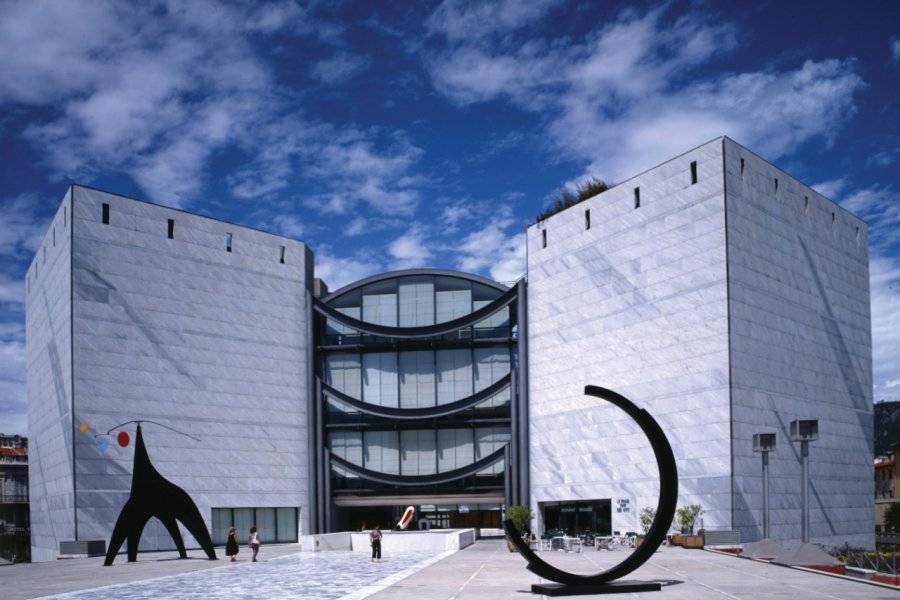Opening time and information on MUSEUM OF MODERN AND CONTEMPORARY ART - MAMAC
Open all year round. Closed on Monday and January 1st, Easter Sunday, May 1st, December 25th. Tuesday to Sunday from 10 am to 6 pm. Free until 18 years old (and to all inhabitants of the Nice metropolis). Adults: 10 € (7 days rates at 20 €). Children welcome. Guided tour. Store. Animations.
Owner's Message
THE MAMAC
History
Inaugurated on June 21, 1990, the MAMAC has gradually assembled, under the direction of Claude Fournet and Pierre Chaigneau, a magnificent collection in terms of its quality and richness. The arrival in 1996 of Gilbert Perlein at the head of the museum continued these commitments and gave a new impetus to an ambitious exhibition program that gave the institution a prominent place on the international art scene.
The Museum of Modern and Contemporary Art of Nice (MAMAC) is part of a cultural complex that includes the National Theater of Nice, the Municipal Library with a Regional vocation and today the Forum of Urbanism. It will soon be connected to the Coulée Verte, a huge 12-hectare urban park leading to the seafront. Open to the public, the museum's terraces offer a unique view of the city.
Its missions
⇨ A RICH AND DIVERSIFIED XXth-XXIst COLLECTION.
With nearly 1,200 works and more than 300 artists, the MAMAC covers a vast period from the late 1950s to the present day. Its collections find their essential articulation in the relationship between European New Realism and the American expression of assemblage art and Pop Art. The object thus occupies a pivotal place. First-rate focuses complete this research. The Yves Klein room reveals the extent and richness of the artist's approach, thanks to the long-term deposit of the Yves Klein Archives. The Niki de Saint Phalle & Jean Tinguely room constitutes the most important collection of the artist's work in France (and the second largest in Europe) following his donation in 2001.
At the same time, the MAMAC offers a broad sampling of European and American artistic creation over the last sixty years, with unique insights into the leading movements of the twentieth century: Arte Povera, Land Art, Minimalism, American Abstraction, Conceptual Art and New Figuration. Finally, this narrative is enriched by the presentation of artists from the art scene of the 1980s to the present day, marked in particular by advertising aesthetics, figurative painting, the development of personal mythologies and misappropriation.
The major challenge of the MAMAC is to link regional and international artistic history insofar as the Côte d'Azur has been marked by an artistic emulation around the act of appropriation (with the New Realists), attitude art (with Fluxus) and the questioning of the painting (with Support/Surface) which continues with the new generations.
Through the constant renewal of its displays and the presentation of its new acquisitions or donations, the MAMAC reveals to the public the abundance and extent of its permanent collection.
⇨ A DYNAMIC ARTISTIC PROGRAM WITH INTERNATIONAL INFLUENCE.
Over the years, this museum has been able to offer beautiful confrontations of creation instituting a truly fruitful dialogue. Alongside collective events such as "Intra-Muros" (2004) where 21 international artists were invited to invest a wall, "La Couleur en avant" (2011), "Klein-Byars-Kapoor" (2012) or "After Matisse" (2013) ; Tom Wesselmann (1996), Robert Rauschenberg (2005), Jean-Pierre Raynaud (2006), Jaume Plensa (2007), Robert Longo (2009) or Wim Delvoye (2010) have signed a monographic exhibition at the MAMAC in Nice. The young creation legitimately finds its place with projects like "Nouvelle Vague" (1994), "Nice to meet you" (2007). The contemporary gallery and the windows of the MAMAC reinforce this prospective vocation. Today, the public is loyal and follows the museum in its choices with nearly 180 000 visitors per year.
⇨ AN EDUCATIONAL VOCATION.
With the aim of opening up to all types of audiences, the MAMAC offers a program of guided tours and visual arts workshops also relayed by the "no contact" operation that promotes accessibility and understanding of contemporary art to the greatest number. Finally, the auditorium, the documentation center and the online availability of the collection (via Videomuseum or http://www.mamac-nice.org/) extend this didactic objective and provide an indispensable tool for researchers.





Je pleure tous les jours depuis que j'ai appris sa fermeture.
Je t'aime MAMAC, à bientôt ????